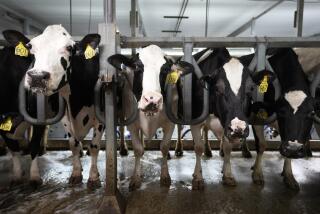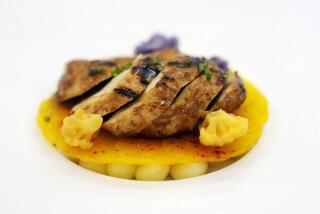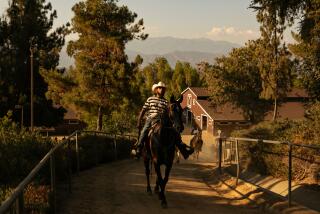Success Breeds Imitation
- Share via
CANUTE, Okla. — In the world of big-money cattle exhibitions, Full Flush is a celebrity.
He has the wide rump, the meaty back and long neck that send cattle judges swooning. Like a bovine teen idol, his jowly face stares out from the catalogs studied by 4-H kids and professional breeders. Many of his 35,000 calves have won state fairs and national stock shows.
But in one important way, Full Flush is not living up to his potential. When it comes to producing semen for sale, the big bull “doesn’t have much of a drive in him,” says his owner, Dean Kephart. “He’s just not that romantic.”
Kephart has sold nearly $2 million in Full Flush semen since 1995, mostly to farm families hoping to breed the next show champion. But he could sell much more. So last year he turned to the latest in cattle technology: He had Full Flush cloned.
Today, five genetic copies of Full Flush trot around Kephart’s dusty Oklahoma pasture. As only the latest of 300 cloned cattle worldwide, their birth last fall was not big news. And yet, these clones now grazing here, on a working farm far from any high-tech laboratory, may be groundbreaking: They may soon be able to make money.
Created for $50,000, the young bulls are an unmistakable sign that cloning is no longer a scientific oddity, instead poised to become a real business.
“To us, a $50,000 cloning bill looks pretty reasonable,” said Don Coover, a Kansas semen broker who hopes to market semen from the clones. “We ... sure intend to turn a profit.”
Across the Farm Belt, cloning is steadily drawing interest as a way to preserve the traits of elite animals. Already in the pen are copies of Starlight, a Texas Longhorn with world-record horns; of Zita, once the top milk producer among Holsteins; and KC, born in essence from a piece of meat -- a cow that was slaughtered before its cells were culled for cloning.
Now two sets of players are grappling with decisions that could determine whether cloning goes beyond the small circle of champion animals.
One is the Food and Drug Administration, which bars the sale of meat, milk and other products from cloned animals while it studies effects on the food supply. Because even top show livestock wind up on dinner plates, the agency has so far stopped Kephart and others from selling cloned animals’ semen.
But the FDA could start to approve cloned products for sale within months. In theory, the agency says, cloned foods should be identical to non-cloned products, and equally safe to eat. By Jan. 1, the FDA hopes to tell producers what data they must supply for each cloned product to win marketing approval.
At the same time, cloning has touched off a roiling debate among the breed associations and clubs that control animal shows and competitions.
Many breeders consider themselves artists, working with genes instead of paints. Their goal is to produce something beautiful, an animal that looks or behaves better than anything seen before. Some argue that cloning reduces the art to mere photocopying.
“You’re filled with anticipation when you put two animals together,” said Kenneth Downing of Tonganoxie, Kan., president of the German Shepherd Dog Club of America Inc. “You hope you’ve made the right match ... and you’ve used all the knowledge that you’ve gathered over the years about what lines work together.
“Cloning takes all that away,” he said. “You know what you’re going to get: an almost identical copy.”
“How can you allow these animals in a show?” asked Fred Nessler, a Springfield, Ill., lawyer and board president of the Maine-Anjou cattle breed association. “I mean, they aren’t a bred animal. They’re a copied animal.”
But if a champion animal is built from champion genes, why not let everyone work with the best materials? That’s where cloning can come in, advocates say, not necessarily to produce cloned animals for show, but to make the semen and eggs of top animals more widely available to breeders, who would continue to combine them in new ways.
Kephart says cloning will allow him to cut the price of Full Flush semen in half and sell it more widely. Mixing it with eggs, breeders would still spin the genetic roulette wheel each time they produced a new animal.
So far, clubs devoted to companion animals have rejected this reasoning. Even before the first cloned horse or dog arrives, the Jockey Club has barred cloned thoroughbreds from racing, and the American Kennel Club has excluded cloned dogs from its shows.
The first cat was cloned this year, but Cat Fanciers’ Assn., the largest cat registry, says the copied kitten would not be welcome in its most elite competitions.
The picture is far different in the livestock world. At least eight of the 20 or so associations of cattle breeds have agreed to register clones.
“Most people are pretty open-minded about this stuff, because it’s not completely new to them,” said Tyrone Hullinger, a Harris, Mo., breeder. He said ranchers already routinely use artificial insemination to breed cattle.
The big hurdle, he said, is that people still want proof that a cloned offspring is truly identical to its parent. “I remain a little bit skeptical,” Hullinger said.
At Kephart’s ranch, a flat and treeless expanse west of Oklahoma City, cloning appears to live up to its billing as the breeders copying machine.
Five jet-black bulls, handily named Full Flush 1, 2, 3, 4 and 5, frolicked one recent day like overgrown sheep, nosing each other aside for the chance to chew on Kephart’s beefy hand.
“To me, it’s incredible that every one of them has the same face and head,” said Kephart, 45, a tank of a man in a baseball cap, worn T-shirt and ratty tennis shoes. “Their tail sets into the butt in the same way. Their bones are all the same.” The only difference among the clones, Kephart claimed, is that one is somewhat smaller because of an illness shortly after birth.
Kephart grew up in Canute (population 524), on a ranch that produced cattle for the beef industry. Like many farm kids, he got into cattle breeding as part of the “club calf” circuit, a series of events run by 4-H and other organizations that aim to teach good animal care.
Today, Kephart’s office is full of photographs and trophies from years of exhibitions as he talks about breeding. What if we put Heatseeker into that cow from last year? Should we use some of that old Jetliner semen?
“People started following what he was doing, because he was winning everything,” said Christy Collins, a livestock marketer from Oklahoma City. “Today, a lot of people are still trying to follow his breeding program because he is so successful.”
“It’s just something where you get a feeling,” Kephart said modestly. “We take long necks and big butts and put them together to get something better than the past was.”
During Kephart’s career, the club calf circuit became big business, though it is still a tiny part of the beef industry. Just as some parents hire private Little League coaches for their kids, farm families are increasingly willing to pay high prices so that their children have a solid calf to raise as part of a 4-H project.
Cattlemen and adult hobbyists have also gotten more aggressive in competing at the biggest stock shows. “When you have champion steers selling for $50,000 and $60,000 -- the champion at Houston has sold for $500,000 -- then it gets very competitive,” said J. Willard Lemaster, an animal education specialist at the University of Maryland.
Now, the cattle exhibition world has its stars -- animals who have a proven record of making winners. Bulls such as Draft Pick, Sugar Ray and Full Flush command top dollar. U.S. semen sales top $200 million annually.
Don Coover, of Galesburg, Kan., had that demand in mind when he learned about cattle cloning at a lecture three years ago. A West Point graduate and veterinarian, Coover markets semen for a variety of breeders through his company, SEK Genetics/Genetic Horizons. He started to research cloning and eventually brought an idea to Kephart: They would clone Full Flush to boost their supply.
“OK, build me 10 of them,” Kephart said. He did not believe it would work.
Coover took some skin cells from Full Flush’s ear and gave them to Cyagra of Worcester, Mass., one of several small companies that offer commercial cloning services.
Full Flush’s cells, which carried the bull’s DNA, were inserted into cow eggs that had been stripped of their own genetic material. Then, the eggs were induced to divide. The resulting embryos had genes only from Full Flush, instead of from the traditional cow and bull.
By transferring the embryos to surrogate mothers, Cyagra produced five clones for $10,000 apiece. “We’d like to think we can get more efficient, to where in five years it will be $5,000,” said Ron Gillespie, a Cyagra vice president.
If the price drops enough, Coover and Gillespie say, cloning could have a big impact in the beef industry, a far larger business than the club calf circuit. They say cloning would offer two advantages.
First, it would bring more uniformity to a cattle herd. Today, variations from one animal to the next create problems for feed-lot operators and slaughterhouses. One animal might need six months of grazing and four months of grain feeding to reach slaughtering weight, while the next might need five months of each.
In the poultry industry, by contrast, centralized breeding by a few large companies has created birds that grow at more uniform rates.
A flock destined for fast-food outlets will consist entirely of 5-pound birds, with only a few ounces of variation, said Richard Lobb of the National Chicken Council. That makes it easy to automate the equipment that kills and cleans the birds. And the end product is consistent in weight and quality, something that grocers and fast-food outlets demand.
Cloning, its advocates say, could create more consistent cattle herds by producing genetically identical bulls to service a rancher’s cows.
Cloning might also make the work of the rancher easier.
Breeding season, which comes twice a year, is exhausting for Kephart. Full Flush can service some of his 700 cows, but the rancher uses artificial insemination so that the rest produce good calves.
Riding horses or all-terrain vehicles, Kephart and his two helpers patrol the 7,500-acre ranch to find out which cows are in heat. Then they have to pen the cows, thaw the straws of semen and inseminate the animals with a catheter. Afterward, they have to monitor the cows so they can try again with those that failed to become pregnant.
The process takes more than a month.
“This is seven days a week, and a person wants to take off once in a while,” Kephart said. “I love what I do, but the hours can really catch you.”
With a few more versions of Full Flush, Kephart would merely turn the bulls out to pasture and let them handle all the cows. “That would be a pretty big deal,” he said.
Some critics have a more disturbing vision. A herd of identical bulls mating with identical cows, they say, would leave the breed without the diversity needed to withstand disease.
Some also believe consumers are squeamish about cloning and might be scared off the beef.
“Ultimately, I think it would sound the death knell for the family ranch,” the Maine-Anjou group’s Nessler said. “It isn’t a very hard stretch to believe that large industries would say, ‘Why do I need to buy a bull from rancher Jones? I’ll simply clone as many of these as I need.’ ”
But some ranchers are eager to try cloning, even before the FDA allows them to sell what they create. Others are preserving cells from their most valuable animals, at about $1,000 apiece.
If nothing else, saving cells is a kind of insurance policy.
Buck White learned that the hard way. The Sterling, Okla., cattleman and a partner owned a bull named Icepick, who was a popular sire of club calves. “He was selling real good,” White said. “It was like winning the lottery in the cattle business.”
Coover tried to persuade White to save some cells from the bull, but White never did. Then in August, disaster struck while Icepick was out in a pasture, servicing some cows.
“The neighbor’s bull broke through the fence and whooped him mean, tore him up pretty good,” White recalled. “We took him to the vet to try to save him, but they couldn’t do it.”
Icepick was dead when the veterinarian culled some cells from the animal’s ear. Today, those cells have been passed to Cyagra, and White and his partner hope to be selling semen one day from an Icepick clone. They have already established several pregnancies.
“I’m just a little old cowboy in the cow trade in the middle of nowhere, and look at all this,” White mused.
“I mean, it’s crazy, really. It’s almost unreal.”
*
A Growing Stable of Clones:
Dolly the sheep is the world’s best-known clone. But other clones are celebrities as well, at least among breeders of championship cattle. Following are some well-known clones and their “parents.”
Zita
Legendary Holstein was once No. 1 U.S. milk producer
Owned by Greg Wiles of Williamsport, Md.
Two clones, born February 2001
Cole First Down 46D
Prized Limousin bull, his production of semen was limited by an injury
Owned by Larry Coleman of Charlo, Mont., and others
Clone announced in February 2001
Full Flush
Prized mix-breed sire of show cattle
Owned by Dean Kephart of Canute, Okla.
Five clones, born November 2001
Who Made Who
Popular sire of show cattle, a mix of Angus, Chianina and Maine-Anjou; owned by Phil Lautner of Jefferson, Iowa; two clones, born December 2001
KC
Calf cloned from a slaughtered cow, a mix of Angus and Hereford; owned by ProLinia Inc. of Athens, Ga.; born April 2002
Starlight
Texas Longhorn with record for longest horns; owned by Dallas physician Zech Dameron; five clones, born spring 2002
More to Read
Sign up for Essential California
The most important California stories and recommendations in your inbox every morning.
You may occasionally receive promotional content from the Los Angeles Times.













